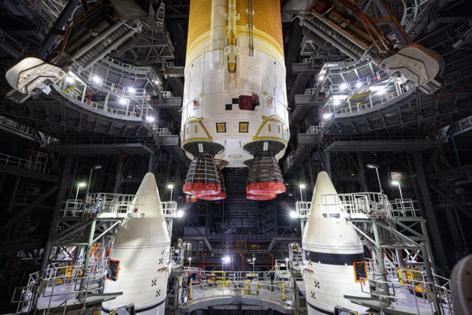NASA takes possession of Orion for Artemis II moon mission
Published in Science & Technology News
For the first time since Apollo 17 in 1972, NASA officially has its hands on a spacecraft expected to fly humans to the moon.
Lockheed Martin, prime contractor for the Orion space capsule, transferred possession of the Artemis II spacecraft Thursday to the agency’s Exploration Ground Systems team base at Kennedy Space Center.
Artemis II is slated to launch from KSC no later than April 2026, taking NASA astronauts Reid Wiseman, Victor Glover, Christina Koch and Canadian astronaut Jeremy Hansen on a 10-day mission around the moon — but not to the lunar surface. That launch date is one that’s been repeatedly delayed after completion of the uncrewed Artemis I mission in late 2022.
“We want to achieve a pace of one flight a year. We’re not there yet,” said Lockheed Martin’s Kirk Shireman, head of its Orion program. “We all know that the faster you fly, the faster you produce vehicles, the cheaper they are, the less cost there is to that and the more you keep the interest of the public.”
Artemis II will be the third flight to space for Orion, which was originally part of the Constellation program started under President George W. Bush. It survived that program’s demise and was incorporated into what became Artemis, designed to be launched atop the massive Space Launch System rocket for deep-space missions.
Orion performed a short test trip to space in 2014 before flying on the Artemis I mission in 2022 that orbited the moon without crew.
That flight brought Orion back to Earth at nearly 24,500 mph enduring temperatures of 5,000 degrees Fahrenheit. Unexpected damage found on the heat shield’s protective coating prompted an investigation that forced NASA to punt Artemis II further into the decade from its original timelines.
As recent as late 2020 under President Trump’s first administration, NASA was still holding to the lofty, although ultimately unrealistic goal of flying Artemis I in 2021, Artemis II in 2023 and Artemis III — which aimed to return humans to the lunar surface in 2024.
Artemis I ended up flying one year later than planned. Damage to the mobile launcher from the 8.8 million pounds of thrust created by the SLS rocket in addition to Orion heat shield issues were prime factors in Artemis II slipping first into 2024, then 2025 and now not until early 2026.
NASA had asked all of its partners in the Artemis program to see if they can exceed deadlines and get to flight as early as February while keeping Artemis III on NASA’s calendar for summer 2027. Artemis III is reliant on SpaceX to develop a working version of its Starship rocket to act as the human landing system.
“We are working to even accelerate our work production for flights for Artemis 3, 4, 5 and beyond. NASA has been working with us and encouraging us to continue doing that,” Shireman said. “The direction we’ve been getting from NASA is, ‘Hey, we’ve got to meet our dates, and it would be awesome if you could exceed, if you could do better than those dates,’ and and that’s the way we’ve been working.”
He said a new issue that popped up late last year regarding Orion’s batteries had teams projecting a final delivery at the end of May.
“I think we’re extremely proud to have been not only able to hold, but accelerate that date,” he said noting Lockheed gained back nearly a month. “That’s pretty phenomenal in a complicated spacecraft.”
Orion will eventually be stacked atop the SLS rocket in the Vehicle Assembly Building, after which the completed rocket and spacecraft atop the mobile launcher could roll to Launch Pad 39-B before the end of the year for testing where NASA intends to keep it until launch.
Shireman said he thinks NASA is happy with Lockheed’s performance.
“It wasn’t like everything was smooth sailing,” he said saying many issues were found and solved before they became a schedule threat. “People have really been working hard and are probably more than a little fatigued. So they’re going to take a breather here for 24, maybe 48 hours, and then we’re going to hit it again for Artemis III.”
Shireman said Lockheed has not had any signal from NASA to pull back from long-term plans with Artemis even though the future of the SLS rocket and Orion spacecraft could shift under new direction during the second Trump administration.
The delays to Artemis, along with ballooning costs, has critics including billionaire Jared Isaacman, who was nominated to become the next NASA administrator and is awaiting a confirmation vote in the Senate.
Isaacman has told senators he’s on board with the plan through at least Artemis III, especially as the U.S. tries to compete with Chinese plans to land on the moon. But after achieving the lunar landing, the nation should look at commercial alternatives such as SpaceX’s Starship or Blue Origin’s New Glenn for achieving its lunar goals.
Shireman continued to stump for the current plan to fly Orion atop SLS in the short term even though plans could change.
“You could launch an Orion on a New Glenn and you could create an architecture,” he said. “But when you add new elements that don’t exist and you haven’t started working on them, that’s where the time comes in.
“So that’s why I believe, firmly believe, the quickest way to the moon — to put American boots back on the moon — is with SLS and Orion on Artemis III.”
But he pitched the spacecraft to remain part of whatever the future of deep-space exploration becomes.
“Ultimately, we could pivot to something different,” Shireman said. “We want to be part of putting Americans back on the moon and a sustainable lunar program. And if the administration wants to modify the architecture, we’ll be happy to to work with them.”
----------
©2025 Orlando Sentinel. Visit at orlandosentinel.com. Distributed by Tribune Content Agency, LLC.







Comments